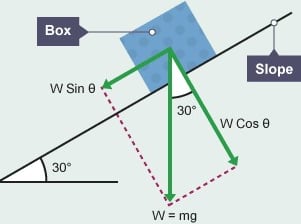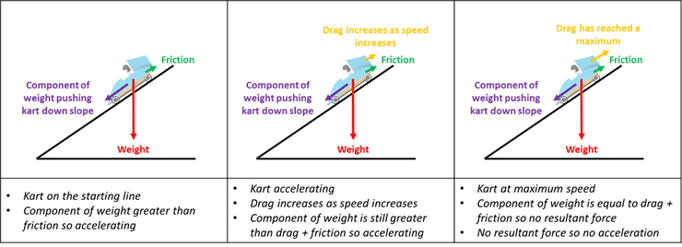The physics of gravity racing
An introduction to the physics involved in gravity racing and how this impacts the design of a gravity kart
2 min read
Gravity
There is only 1 force that is making the gravity kart accelerate and that comes from its own weight. When the kart is on a slope a component of the weight acts down the slope and it is this force that causes the kart to accelerate. The steeper the slope the greater the force to accelerate the kart.
Imagine the box in the picture is our kart and let's assume that it has a mass of 100kg. This means that the weight of the kart is 100 x 9.81 = 981 Newtons. Now let's calculate how much of that 981N is actually trying to push it down the slope. To calculate this we just need a bit of trigonometry:
981 x Sin(30⁰) = 490.5 Newtons
If there were no other forces involved we could then use Newton's 2nd Law to calculate the acceleration of the kart. Newton's 2nd Law is: F=ma, so acceleration = F/m
490.5/100 = 4.905 m/s²
Unfortunately, there are other forces involved which reduce this acceleration. When designing our kart we need to minimise the resistive forces so we get the maximum acceleration possible.
Resistive Forces
There are two main types of resistive forces which are acting against the kart that we need to consider, friction and drag. The friction force will come from things such as, friction in the bearings, tyre pressures, alignment of wheels, etc. The drag is created due to the kart moving through the air and changes depending on the speed of the kart.
Maximum Speed
A kart will reach a maximum speed when the resultant force acting on it is zero. When the kart initially starts it has the greatest resultant force so will accelerate the quickest. As it speeds up the drag increases which reduces the overall resultant force and therefore reduces the acceleration. Eventually, when you are going fast enough the drag will reach a maximum and the kart will have no resultant force and will have reached its maximum speed. See the diagrams below to visualise the forces at each stage:
In order to reach the maximum highest speed we need to have our kart as heavy as possible within the rules of each event. However, we also need to consider how increasing the mass will affect the kart when cornering so the mass will become a compromise. It will be good to design our soapbox to use ballast as this will allow the mass to be changed from event to event.




